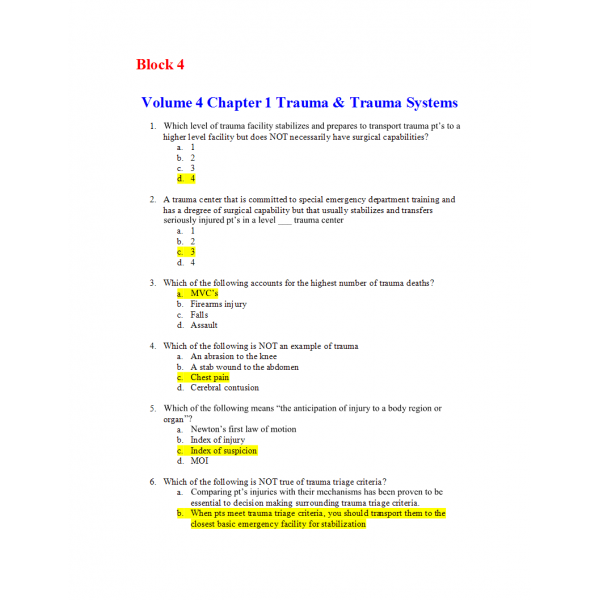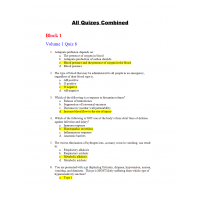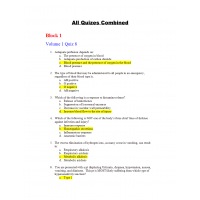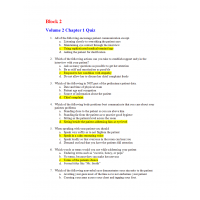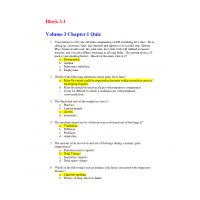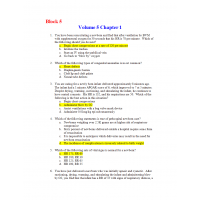PAR 100 San Diego Miramar College Vol 4
PAR 100 Volume 4 Chapter 1 Trauma & Trauma Systems
1. Which level of trauma facility stabilizes and prepares to transport trauma pt’s to a higher level facility but does NOT necessarily have surgical capabilities?
2. A trauma center that is committed to special emergency department training and has a dregree of surgical capability but that usually stabilizes and transfers seriously injured pt’s in a level ___ trauma center
3. Which of the following accounts for the highest number of trauma deaths?
4. Which of the following is NOT an example of trauma
5. Which of the following means “the anticipation of injury to a body region or organ”?
6. Which of the following is NOT true of trauma triage criteria?
7. A trauma system is based on the principle that serious trauma is a ______ disease.
8. Which of the following is more relevant to the assessment of a trauma pt that to the assessment of a medical pt?
9. As a paramedic, your role in trauma care consists of all the following EXCEPT:
10. The purpose of determining the MOI and the index of suspicion for the trauma pt at the same time is to allow you to:
11. Which of the following requires immediate transport to a trauma center?
12. Which of the following MOI does NOT call for immediate transport to a trauma center?
13. In addition to handling all types of specialty trauma, which level of trauma center provides continuing medical and public education programs?
14. The leading cause of death in people under age 44 is:
15. Which of the following is important to the assessment of the trauma pt but not to the medical pt?
16. Which of the following is NOT considered a significant MOI for a pediatric pt?
17. Which of the following pts is not a candidate for air medical transport?
18. Written and verbal communication of the MOI and suspected injuries prevents under triage and insures the pt will receive the appropriate level of care.
19. Which of the following physical findings indicates the need for immediate transport?
20. Which of the following is an acceptable way of reducing prehospital time to maximize the use of the “golden hour” for trauma pts
21. Which of the following pts does NOT require specialty center capabilities beyond that offered by a trauma center?
22. Which level of trauma facility has minimal surgical support but can stabilize before transferring to a higher level trauma facility?
23. Which level of trauma facility can handle the most common trauma emergencies but for more specialized care will have to transfer the pt to a regional trauma center?
24. Upon arriving on a scene where the MOI indicates a potentially life threatening injury and transport time is prolonged, which of the following interventions will best help deliver the care that is needed?
25. Which of the following is not a consideration when assessing a trauma pt?
26. Which of the following acts resulted in the development of modern EMS systems?
27. Which of the following is the best, most cost effective way for EMS personnel to help reduce trauma related morbidity and mortality?
28. Which of the following mechanisms would yield the greatest index of suspicion for injury?
29. Which of the following statements about trauma is true?
Volume 4 Chapter 2 Blunt Trauma
1. In frontal impact collisions, which pathway of patient travel results in higher mortality?
2. In falls, which section of the spinal column is the most prone to compression?
3. Which of the following statements about the impact of motorcycle helmet usage is true?
4. Which of the two following factors proportionately affect the kinetic energy of a bullet fired from a gun?
5. People in which of the following age groups are prone to significant trauma due to falls?
6. Which of the following injuries is associated with the pressure wave produced by a blast?
7. Which of the following impacts the severity of injury sustained in a motor vehicle collision?
8. Which of the following injuries is most likely in a resr-end collision?
9. Applying Newtons second law of motion to a vehicle traveling 70 miles per hour, crashing into which of the following would transfer the most force to the patient?
10. Upon arriving at the scene of a single vehicle collision in which the vehicle struck a utility pole, you note that the windshield is spidered, or starred, and that the driver was not restrained. Which of the following injuries is most likely?
11. You are dispatched to a building collapse with an entrapped patient who will require a lengthy extrication. Which of the following meds should you consider for this patient while awaiting extrication?
12. In which of the following types of impact should you have a higher index of suspicion because the degree of injury may be greater than the damage alone indicates?
13. Which of the following mechanisms in a motor vehicle collision would most likely result in a tear of the liver at the ligamentum teres?
14. Which of the following best defines the term energy?
15. Which of the following paper bag syndrome injuries may occur due to sudden compression of the thorax or abdomen?
16. Vehicle airbags are meant to :
17. Which of the following injuries is associated with the tertiary phase of a blast?
18. Which of the following traumas contributes most significantly to motor vehicle collision mortality?
19. Which of the following contributes to a greater degree of injury than anticipated from vehicle damage alone in a lateral impact motor vehicle collision?
20. You are called to the scene of a vehicle crash in which a car was rear ended while stopped at a stop sign. Which of the following laws of physics serves as the basis for analyzing the mechanism of injury and the associated suspicion of index for injuries?
21. Which of the following is true of the differences between adult and pediatric pedestrians when struck by a vehicle?
22. In a motor vehicle collision, when the drivers chest strikes the steering wheel, what produces injury next?
23. Which of the following is true of supplemental restraint systems?
24. Your patient, a 23 yo woman who is 6 months pregnant, was the unrestrained driver of a vehicle that rear ended a parked car. The airbag deployed. For which of the following injuries should you maintain a high index of suspicion?
25. Which of the following factors is NOT a consideration in the severity of injury related to falls?
26. Which o the following best describes what happens to the kinetic energy of a vehicle traveling at 65 mph when it collides into a concrete barrier wall?
27. Which of the following is true of motorcycle collisions?
28. Frontal impacts in which the patient takes a down and under pathway typically result in which of the following injury patterns?
29. Which of the following statements about lateral impact collisions is true?
30. Which of the following is NOT a complication of crush syndrome?
31. The two factors that refer to the rate of change of speed are
32. Axial loading is most likely to occur in which type of impact?
33. Which of the following best describes why the occupants of a vehicle moving at 50 MPH will be injured when the vehicle strikes a tree but not when it brakes to stop?
34. Which of the following injuries is NOT associated with the use of vehicle restraint systems?
35. A vehicle is struck in its right front as it passes through an intersection, resulting in a rotational impact. Which of the passengers is subjected to the greatest acceleration forces?
Volume 4 Chapter 3 Physics of Penetrating Trauma
1. Which of the following statements about stab wounds is true?
2. As the mass of an object increases, which of the following occurs?
3. Which of the following statements about bullets is true?
4. Which of the following increases a bullets profile?
5. Your patient is a 60 yo male with a gunshot wound in the second intercostals space anteriorly on the left. You note that he has frothy blood coming from his mouth. For which of the following must you have the highest index of suspicion?
6. The path a projectile follows during a flight is called its:
7. Which of the following is true of shotgun ammunition?
8. To gain an appreciation for the potential for trauma from high velocity projectiles, it is important to remember that the shock wave produced can exceed atmospheric pressure by up to ----- times.
9. Penetrating trauma to the face can complicate airway management by which of the following mechanisms?
10. The initial assessment of a patient with a gunshot wound to the chest should focus on detecting which of the following/
11. Which of the following is typical of the trajectory of a knife when a female assailant stabs someone/
12. Which of the following is true of the shock wave that accompanies high velocity penetrating trauma?
13. Which of the following is NOT considered penetrating trauma?
14. Which of the following organs would be most likely to be injured by a stab wound to the 6th intercostals space in the Midaxillary line on the right side?
15. Your patient is a construction worker who fell 15 feet and has a 3 foot metal concrete reinforcement bar (rebar) impaled in his right thigh. Which of the following is the best action?
16. Which of the following bullet characteristics would create the most damage?
17. Which of the following characteristics of stab wounds is associated with a male attacker?
18. Which of the following is considered a high velocity weapon?
19. As the energy from a medium or high velocity projectile pushes tissue from its path, which of the following occurs?
20. Greater velocity of a bullet will cause a ____ path of travel and a ____trajectory.
21. You have arrived on the scene of a 17 yo male with a gunshot wound to the thigh. Police are on the scene. There is significant ongoing hemorrhage from the wound. The patient is screaming for someone to help him. Which of the following should you do first?
22. Which of the following is true of body armor use?
23. Which two factors related to kinetic energy proportionately affect the damage a projectile will do?
24. Which of the following abdominal organs is the least affected by the pressure wave associated with penetrating trauma?
25. Which of the following statements about entrance and exit wounds is true?
26. Which of the following statements about low velocity penetrating trauma is true?
27. Which of the following organs is most susceptible to damage from the pressure wave when a bullet enters it?
28. Which of the following is most important when assessing the damage done by a gunshot?
29. Your patient is an 8 yo male with a pencil impaled 2 centimeters inferior to the xiphoid process. You note that the pencil is pulsating. Which of the following is the best action?
30. A penetrating injury to which of the following organs is LEAST likely to result in severe hemorrhage?
31. Which of the following statements is true of the permanent cavity created by penetrating trauma?
32. During the scene size up on a call for a patient with a penetrating trauma due to a stab wound, which of the following should you do?
33. Your patient is a 50 yo male with a gunshot wound to the right anterior chest. He is unresponsive. Which of the following should you do first?
34. Your patient is a 30 yo female with a stab wound to the neck. She is sitting up and appears very anxious and SOB. There is minimal external bleeding noted, but there is bubbling from the wound. Which of the following should you suspect, based on the mechanism of injury and assessment findings?
35. As a bullet tumbles, its potential to inflict damage:
36. Which of the following is best described as the area of contused tissue resulting from penetrating trauma that may be slow to heal due to disrupted blood flow and tissue damage?
37. Which of the following is associated with assault rifle wounds but not hunting rifle wounds?
38. Your pt has a gunshot wound to the left posterior thorax. Which of the following is not appropriate in your initial assessment?
39. When assessing a pt with a gunshot wound to the chest, which of the following findings would tell you the most about the amount of damage?
40. Which of the following is most likely to occur when military ammunition is used?
41. Which of the following is true of the temporary cavity formed by penetrating trauma?
42. Which statement about ballistics is true
Volume 4 Chapter 4
1. Which of the following mechanisms is responsible for accumulating lactic acid in shock?
2. Which of the following substances has the most rapid effect when compensating for hemorrhage?
3. Which layer of the arteries controls the diameter of the vessel?
4. Which of the following types of wound facilitates the effectiveness of normal blood-clotting mechanisms?
5. Your patient is a 29-year old male who works in a meat-processing plant. He received a knife wound in the proximal antero-medial thigh, which is continuing to bleed on your arrival. He is restless, thirsty, and has pale, cool skin. He has a weak radial pulse of 130 and a blood pressure of 118/88. this patient is exhibiting signs and symptoms consistent with stage _____ hemorrhage.
6. Your patient is an obese 39-year old woman involved in a lateral-impact motor vehicle collision. Which of the following should you remember when assessing and treating this patient?
7. Which of the following is true of the elderly trauma patient?
8. When cells become hypoxic and the amount of carbon dioxide in them increases, reducing tissue pH, which of the following occurs to restore homeostasis?
9. rapid volume replacement is best achieved under which of the following conditions?
10. For which of the following mechanisms of should you maintain the highest index of suspicion for hemorrhagic shock?
11. The increase in myocardial contraction as a result of increased blood return to the heart best describes:
12. Managing a laceration with arterial bleeding most often requires:
13. Which of the following guidelines applies to the prehospital administration of IV fluids in the patient with hemorrhagic shock?
14. Your patient is a 23 yo male with a gunshot wound to the abdomen and an exit wound in the right flank. He responds to verbal stimuli; has pale, cool, diaphoretic skin; a heart rate of 128; resp. at 24; and a B/P of 82/60. These findings indicate which of the following kind of shock?
15. Which of the following, located in the aortic arch, monitor blood pressure and send feedback to the medulla oblingata to maintain homeostasis?
16. Under normal circumstances, at any given moment, most of the blood is in the___ system.
17. Which of the following fluids is appropriate for the prehospital management of hypovolemic shock?
18. The phase of blood clotting in which the smooth muscle of an injured blood vessel contracts is known as the ____ phase.
19. A hematoma resulting from a fracture of the humerus may contain enough blood to make it a Stage ------ hemorrhage.
20. Which of the following best describes the importance of O2 in cellular metabolism?
21. Which of the following impairs blood clotting?
22. Septic shock is a form of which of the following types of shock?
23. Which of the following indicates that a patient has transitioned from compensated to decompensated shock?
24. Which of the following results from anaerobic metabolism in shock/
25. Which of the following is NOT a benefit of PASG?
26. Even with intervention, survival is unlikely with blood loss over____ percent of the total blood volume.
27. Which of the following best describes definitive care for the trauma patient with ongoing, significant hemorrhage?
28. Anaphylactic shock is a form of ____shock.
29. Which of the following results from the Beta-1 actions of epi in response to shock?
1. Increased inotropy
2. Increased chronotropy
3. Increased dromotrophy
4. Bronchiolar smooth muscle relaxation
5. Increased peripheral vascular resistance
30. Your patient is a 42 yo male with multiple lacerations on his arms, head and torso after falling through a plate glass window. On your arrival, he appears to be unresponsive, lying prone on the sidewalk. Which of the following is the correct sequence of actions in caring for this patient?
31. Which of the following is the preferred fluid for resuscitation in hemorrhagic shock?
32. Which of the following results from relaxation of the postcapillary sphincters in shock?
33. Which of the following is NOT a characteristic of arterial bleeding?
34. Your patient has a possible pelvic fracture from a frontal MVC. She has a blood pressure of 78 palp, and a HR of 130 and responds only to painful stimuli. Before you arrived, BLS providers immobilized the patient to a long backboard. Which of the following should your do next?
35. Red blood cells make up approximately ____ percent of whole blood volume.
36. Which of the following measures effectively controls bleeding in body cavities?
37. Which of the following early signs of shock is easily missed?
38. A fracture of the femur may result in a hematoma that contains enough blood to make it a Stage ____ hemorrhage.
39. Which of the following vessels has the greatest ability to change diameter?
40. In a previously healthy individual, which of the following types of shock may NOT result in the typical signs of cool, pale, moist skin; tachycardia, and narrowed pulse pressure?
41. Assuming all of the following pts have experienced significant blood loss and are hypotensive, in which would the use of PASG be absolutely contraindicated?
42. Which of the following terms is best described as the loss of blood from the vascular space?
Volume 4 Chapter 5 Soft tissue injuries
1. Which of the following statements about crush injuries is true?
2. The most common type of trauma is:
3. You are called to a commercial creamery where an employee got his arm trapped in the ice cream mixing machinery. You note that the skin has been pulled off his hand and arm from the midforearm down. The pts muscles, tendons, and bones are exposed. This type of injury is a(n):
4. Your pt is a 15 year old soccer player who was kicked in the calf by another player. She has a contusion on her calf, but the amount of pain she is experiencing seems out of proportion to the apparent injury. You note that, although you can palpate a pedal pulse, there is swelling in the foot and ankle, and the skin is cool to the touch. You should suspect which of the following at this time?
5. For most open, soft tissue wounds managed by the paramedic in the prehospital setting, which of the following are desirable characteristics of the dressing and bandaging materials?
1. Occlusive
2. Non-occlusive
3. Adherent
4. Nonadherent
5. Absorbent
6. Nonabsorbent
7. Sterile
8. Nonsterile
9. Wet
10. Dry
6. The layer of skin that contains adipose tissue is the:
7. Which of the following best describes a wound in which pathogens may be introduced deep into the tissues, increasing the risk of infection?
8. In which type of soft tissue injury is the skin cut or torn, leaving a flap of skin attached?
9. You are on the scn where a 35 year old male has his leg trapped under a section of concrete. While awaiting removal of the concrete, which type of IV fluid is indicated for administration to this pt?
10. You arrive on the scene of a pt with severe blunt trauma to the face. You hear gurgling as you approach the pt. What should your next action be?
11. Your pt is a 3 year old male who has struck his head on a concrete patio. He has a wound that penetrates the dermis and is approximately 2cm long. This wound would be best described as an:
12. A laceration that is perpendicular to the tension lines of the body is more likely to:
13. Which of the following best explains why capillary oozing from minor, open, soft tissue trauma may not stop immediately?
14. Your pt is a 45 year old type 2 diabetic who has had a nonhealing wound on his right foot. You note that the right leg is discolored, edematous, and has subcutaneous emphysema and a foul odor. Which of the following should you suspect?
15. The tough, fibrous sheaths that bundle skeletal muscle are called:
16. Which of the following is best described as the accumulation of a pocket of blood in the tissues?
17. Which of the following best describes the skeletal muscle degeneration secondary to crushing trauma that causes the release of metabolic by products?
18. You have responded for an injured person at an address you know to be a motorcycle clubhouse. Your pt was attacked by another party with a broken beer bottle. Your pt has a large laceration on her neck with moderate bleeding. Which property of your dressing material is most important in caring for this pt
19. In which of the following ways does the integumentary system protect the body against pathogens?
20. You are assessing an assault victim and note a contusion over the abdomen. Which of the following should you remember while caring for this pt?
21. Which of the following may result from an improperly applied tourniquet?
22. When caring for an amputated part, which of the following principles apply?
1. Place the part in a plastic bag or basin filled with sterile saline
2. Place the part in a dry plastic bag and seal it
3. Always transport the part with the pt
4. Keep the part dry and place it in a container of cold water
5. Keep the part dry and place it in an ice filled container
Volume 4 Chapter 6 Burns
1. During which phase of a burn injury does extravasation of proteins, water, and electrolytes occur, resulting in edema and potential hypovolemia?
2. Which of the following body structures is the best electricity conductor?
3. Which of the following is true of the heat generated when electricity flows through the body?
4. Alkalis generally cause_____ extensive burns because they result in ______ necrosis of the tissue.
5. Your patient has circumferential full-thickness burns of the thorax. He is intubated, and you have noticed an increase in resistance as you bag him. His skin is very tight and inflexible as you try to ventilate. Which of the following is required to improve this patient’s ventilatory status?
6. Which of the following body areas warrant special attention when burned?
7. For which of the following burn patients could you use local cooling?
8. Which of the following afents is indicated for pain control in a patient with 4.5 percent partial-thickness burns?
9. Which tissue layer is affected by partial-thickness burns?
1. Epidermis
2. Dermis
3. Subcutaneous
4. Muscle
10. You are dispatched to a structure fire at which there is a report of a burned person. Your patient is a 32 yo male with blisters on his anterior chest and circumferential superficial burns to both lower extremeties. Using the Rules of Nines, what percent of burn does this patient have?
11. The three
| Institution & Term/Date | |
| Term/Date | San Diego Miramar College |
-
$30.00

